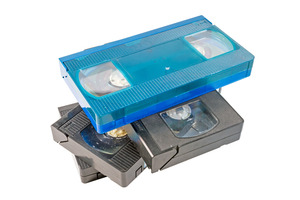ONE OF EVERY FORMAT!
We are constantly on the lookout for rare and hard to find equipment that can transfer obsure formats. Here is a list of formats. The ones we own are indicated in blue! But may need to be restored to working order.
Much of this equipment was manufactured in the 1970’s and 80’s so may need significant maintenance. As our company grows, we are collecting and repairing these old machines. Hoping to someday own at least one operating version of each!
Here’s our comprehensive list of videotape formats, covering the major consumer, professional, broadcast, and obscure varieties from the 1950s to the 2000s.
Consumer Standard Definition Formats
Common Analog Consumer Formats
- VHS (Video Home System) – Developed by JVC (1976) VHS became the dominant home video format due to its longer recording time and widespread adoption. https://en.wikipedia.org/wiki/VHS
- VHS-C – Compact VHS for camcorders. A compact version of VHS designed for camcorders, VHS-C tapes could be played in standard VHS players using an adapter. https://en.wikipedia.org/wiki/VHS-C
- S-VHS (Super VHS) – Higher resolution VHS. An improved VHS format offering higher resolution, S-VHS was aimed at enthusiasts and semi-professionals. https://en.wikipedia.org/wiki/S-VHS
- Betamax – Sony’s rival to VHS (1975). Betamax offered superior video quality but lost the format war to VHS primarily due to shorter recording times and licensing issues. https://en.wikipedia.org/wiki/Betamax
- Video8 – Small format for camcorders (1985). This compact format was popular for camcorders, offering better portability compared to VHS-C. https://en.wikipedia.org/wiki/8_mm_video_format#Video8
- Hi8 – Enhanced version of Video8 (1989). An enhanced version of Video8, Hi8 provided improved video quality, making it suitable for both consumers and professionals. https://en.wikipedia.org/wiki/8_mm_video_format#Hi8
Digital Consumer Formats
- Digital8 – Sony’s digital version of Hi8 (1999). Digital8 recorded digital video onto Hi8 tapes, combining the digital quality of DV with the familiarity of 8mm tapes. https://en.wikipedia.org/wiki/Digital8
- MiniDV – Widely used digital camcorder format (1995). A widely adopted digital format, MiniDV offered high-quality video in a compact cassette, becoming a standard for home and semi-professional recording. https://en.wikipedia.org/wiki/DV_(video_format)#Magnetic_tape
- MicroMV – Sony’s tiny digital tape (2001, short-lived). Launched by Sony in 2001, MicroMV was the smallest videotape format, using MPEG-2 compression. Despite its size advantage, it saw limited success and was discontinued in 2016. https://en.wikipedia.org/wiki/MicroMV
- D-VHS (Digital VHS) – Digital recording on VHS tape (late 1990s). An advancement of VHS technology, D-VHS allowed for digital recording, including high-definition content, on VHS tapes. https://en.wikipedia.org/wiki/D-VHS
Broadcast and Professional Formats
Analog Broadcast Formats
- 2-inch Quadruplex (Quad) – First broadcast format by Ampex (1956). Developed by Ampex in 1956, this was the first practical videotape format for television broadcasting, using 2-inch wide tape reels. Wikipedia
- 1-inch Type A – Ampex (1965).
- 1-inch Type B – Bosch Fernseh (1970s).
- 1-inch Type C – Ampex/Sony (1976), very popular in TV industry. Introduced in the 1970s, Type C became a standard in broadcast television, offering better quality and easier handling compared to Quadruplex tapes.Wikipedia
- U-matic (3/4″) – Sony (1971), early portable news gathering. U-matic was among the first formats to house videotape in a cassette, widely used in professional and educational settings. Wikipedia
- U-matic SP – Superior quality version.
- MII is a professional analog recording videocassette format format developed by Panasonic in 1986.
- Betacam – Sony (1982), professional version of Betamax. Professional formats developed by Sony, Betacam and its successor Betacam SP offered superior video quality and became staples in television production.
- Betacam SP – Enhanced version, very widely used
Digital Broadcast Formats
- Digital Betacam (DigiBeta) – Sony (1993), standard for broadcast. DigiBeta became a standard for digital video recording in professional environments.
- Betacam SX – Digital, MPEG-2-based.
- MPEG IMX – Sony, compatible with Betacam systems.
- DVCAM – Sony’s pro version of MiniDV. Sony’s professional version of the DV format, DVCAM offered improved reliability and was widely used in professional video production.
- DVCPRO / DVCPRO50 / DVCPRO HD – Panasonic’s pro DV formats. Panasonic’s series of professional digital video formats, offering various levels of quality and resolution for different production needs.
- D1 (Sony/Philips) – Uncompressed digital component (1986).
- D2 (Ampex) – Digital composite (1988).
- D3 (Matsushita) – Panasonic format.
- D5 / D5 HD – Panasonic, high-end digital.
- HDCAM / HDCAM SR – Sony’s high-definition formats. High-definition digital formats developed by Sony, widely used in television and film production for their superior image quality.
Film and Studio Archival Formats
- Type D6 VTR – Philips’ digital HDTV format (1990s).
- Type D9 (Digital S) – JVC’s digital tape (1995).
- Vera – British experimental format.
- EIAJ-1 – Early open-reel ½” consumer video standard (1969).
Obscure, Regional, or Short-Lived Formats
- Video 2000 (VCC). Developed by Philips and Grundig in the late 1970s, this European format featured double-sided cassettes but failed to gain widespread adoption.
- Cartrivision. An early home video format introduced by Avco in 1972, Cartrivision was short-lived due to technical issues and limited content availability. https://en.wikipedia.org/wiki/Cartrivision.
- V-Cord. Sanyo’s proprietary format from the 1970s, V-Cord was one of several attempts to enter the home video market but was eventually discontinued. https://en.wikipedia.org/wiki/V-Cord.
- Akai VT-100 / VT-110 – Early portable VTRs.
- Telcan – UK home system prototype (1963).
- Grundig SVR / Video 2000 / VCC – Philips/Grundig (Europe only).
- Elcaset – Sony’s failed cassette-based Hi-Fi format.
- Revere / MVR / Avco VTR – Early or niche home systems.
- CED (Capacitance Electronic Disc) – RCA (disc-based) https://en.wikipedia.org/wiki/Capacitance_Electronic_Disc
Open-Reel Formats
- Ampex VRX-1000. The first videotape recorder introduced in 1956, using 2-inch wide tape reels, marking the beginning of the videotape era.
- Sony CV Series. Sony’s early consumer open-reel video systems from the 1960s, offering video recording capabilities before the advent of cassette-based formats.
- Shibaden Format – Japanese open-reel tape.
- Akai 1/4″ and 1/2″ systems

